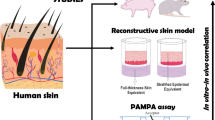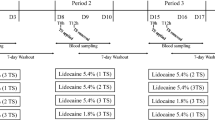Abstract
Purpose. To test the barrier function of a bio-engineered human skin (BHS) using three model drugs (caffeine, hydrocortisone, and tamoxifen) in vitro. To investigate the lipid composition and microscopic structure of the BHS.
Methods. The human skin substitute was composed of both epidermal and dermal layers, the latter having a bovine collagen matrix. The permeability of the BHS to three model drugs was compared to that obtained in other percutaneous testing models (human cadaver skin, hairless mouse skin, and EpiDerm™). Lipid analysis of the BHS was performed by high performance thin layered chromatrography. Histological evalulation of the BHS was performed using routine H&E staining.
Results. The BHS mimicked human skin in terms of lipid composition, gross ultrastructure, and the formation of a stratum corneum. However, the permeability of the BHS to caffeine, hydrocortisone, and tamoxifen was 3-4 fold higher than that of human cadaver skin.
Conclusions. In summary, the results indicate that the BHS may be an acceptable in vitro model for drug permeability testing.
Similar content being viewed by others
REFERENCES
R. L. Bronaugh and H. I. Maibach. In Vitro Percutaneous Absorption: Principles, Fundamentals and Applications, Boca Raton, Fl, CRC Press (1991).
R. Panchagnula, K. Stemmer, and W. A. Ritschel. Animal models for transdermal drug delivery. Methods Find Exp. Clin. Pharmacol. 19:335–341 (1997).
M. Ponec, M. Haverkort, Y. L. Soei, J. Kempenaar, and H. Bodde. Use of human keratinocyte and fibroblast cultures for toxicity studies of topically applied compounds. J. Pharm. Sci. 79:312–316 (1990).
D. A. Godwin, B. B. Michniak, and K. E. Creek. Evaluation of transdermal penetration enhancers using a novel skin alternative. J. Pharm. Sci. 86: 1001–1005 (1997).
I. V. Yannas, J. F. Burke, M. Warpehoski, P. Stasikelis, E. M. Skrabut, and D. P. Orgill. Design principles and preliminary clincial performance of an artificial skin. In Biomaterials: Interfacial Phenomena and Applications. 1982, pp. 476–481.
J. F. Morgan and M. L. Yarmush. Bioengineered skin substitutes. Science & Medicine. 6–15 (1997).
M. Muhart, S. McFalls, R. Kirsner, F. Kerdel, and W. H. Eaglstein. Bioengineered skin [letter]. Lancet. 350:1142 (1997).
T. J. Phillips. New skin for old: Developments in biological skin substitutes [editorial; comment]. Arch. Dermatol. 134:344–349 (1998).
J. F. Trent, R. S. Kirsner. Tissue engineered skin: Apligraf, a bilayered living skin equivalent. Int. J. Clin. Pract. 52:408–413 (1998).
J. G. Rheinwald and H. Green. Serial cultivation of strains of human epidermal keratinocytes. The formation of keratinizing colonies from single cells. Cell 6:331–343 (1975).
E. Bell, H. P. Ehrlich, D. J. Buttle and T. Nakatsuji. Living tissue formed in vitro and accepted as skin-equivalent tissue of full thickness. Science 211: 1052–1054 (1981).
M. Rosdy, B. Grisoni, and L. C. Clauss. Proliferation of normal human keratinocytes on silicone substrates. Biomaterials 12:511–517 (1991).
V. H. Mak, M. B. Cumpstone, A. H. Kennedy, C. S. Harmon, R. H. Guy, and R. O. Potts. Barrier function of human keratinocyte cultures grown at the air-liquid interface. J. Invest. Dermatol. 96:323–327 (1991).
N. Kim, M. El-Khalili, M. M. Henary, L. Strekowski, and B. B. Michniak. Percutaneous penetration enhancement activity of aromatic S, S-dimethyliminosulfuranes. Int. J. Pharm. 187:219–229 (1999).
B. B. Michiak, M. R. Player, J. M. Chapman, and J. W. Sowell. In vitro evaluation of a seies of Azone analogs as dermal penetration enhancers: I. Int. J. Pharm. 91:85–93 (1993).
L. C. Fuhrman, B. B. Michniak, C. R. Behl, and A. W. Malick. Effect of novel penetration enhancers on the transdermal delivery of hydrocortisone: an in vitro species comparison. J. Control. Rel. 45:197–204 (1996).
I. H. Blank, R. J. Scheuplein, and D. J. MacFarlane. Mechanism of percutaneous absorption. 3. The effect of temperature on the transport of non-electrolytes across the skin. J. Invest. Dermatol. 49:582–589 (1967).
C. A. Squier, P. Cox, and P. W. Wertz. Lipid content and water permeability of skin and oral mucosa. J. Invest. Dermatol. 96:123–126 (1991).
D. T. Downing, M. E. Stewart, P. W. Wertz, S. W. Colton, W. Abraham, and J. S. Strauss. Skin lipids: an update. J. Invest. Dermatol. 88:2s–6s (1987).
P. W. Wertz and D. T. Dowing. Stratum Corneum: Biological and biochemical considerations. In Transdermal Drug Delivery, J. Hadgraft and Richard H. Guy. Eds, Markel Dekker Inc., New York, 1989, pp. 1–22.
M. Ponec, A. Weerheim, J. Kempenaar, A. M. Mommaas, and D. H. Nugteren. Lipid composition of cultured human keratinocytes in relation to their differentiation. J. Lipid Res. 29:949–961 (1988).
M. Ponec. Reconstruction of human epidermis on deepidermized dermis: Expression of differentiation-specific protein markers and lipid composition, Toxicol. in Vitro. 5:597–606 (1991a).
P. W Wertz, and D. T. Downing. Glucosylceramides of pig epidermis: Structure determination. J. Lipid Res. 24:1135–1139 (1983).
P. W. Wertz and D. T. Downing. Acylglucosylceramides of pig epidermis: structure determination. J. Lipid Res. 24:753–758 (1983).
Author information
Authors and Affiliations
Rights and permissions
About this article
Cite this article
Asbill, C., Kim, N., El-Kattan, A. et al. Evaluation of a Human Bio-Engineered Skin Equivalent for Drug Permeation Studies. Pharm Res 17, 1092–1097 (2000). https://doi.org/10.1023/A:1026405712870
Issue Date:
DOI: https://doi.org/10.1023/A:1026405712870




